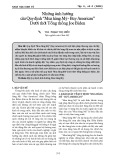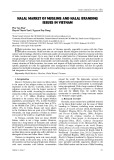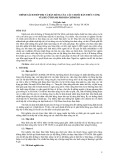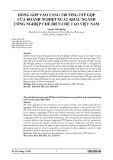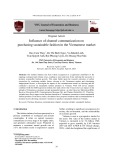
VNU Journal of Economics and Business, Vol. 4, No. 2 (2024) 23-34
23
Original Article
Comparative analysis of the impacts of CPTPP and EVFTA
on Vietnam’s textile export activities
Tran Thi Mai Thanh*, Vu Ba Duy, Luong Minh Ngoc,
Nguyen Thanh Thao, Duong Thi Thu
VNU University of Economics and Business
No. 144 Xuan Thuy Street, Cau Giay District, Hanoi, Vietnam
Received: January 23, 2024
Revised: March 27, 2024; Accepted: April 25, 2024
Abstract: This paper presents a comprehensive comparative analysis of the impacts of two
significant Free Trade Agreements (FTAs) – the Comprehensive and Progressive Agreement for
Trans-Pacific Partnership (CPTPP) and the European Union-Vietnam Free Trade Agreement
(EVFTA) – on Vietnam’s textile industry. Utilizing a quantitative research methodology, the study
systematically examines trade data to assess the relative effects of these agreements. The findings
reveal that the CPTPP exerts a more substantial influence on Vietnam's textile exports compared to
the EVFTA. This is primarily attributed to the CPTPP's more comprehensive market access and
more advantageous tariff reduction schedules, which have significantly enhanced Vietnam’s export
potential in key markets like Canada, Japan, and Mexico. On the other hand, the EVFTA, while
contributing to a steady increase in exports to European markets, demonstrates a less varied impact.
The paper’s unique contribution lies in its in-depth analysis of the differential impacts of these FTAs,
providing critical insights into their role in shaping Vietnam’s position in the global textile market.
The results of this study are particularly valuable for policymakers and trade strategists in developing
and fine-tuning trade policies, highlighting the nuanced effects of different trade agreements on
export dynamics in an increasingly interconnected global economy.
Keywords: CPTPP, EVFTA, textile industry, comparative analysis.
1. Introduction*
In the ever-evolving landscape of global
trade, FTAs play a pivotal role in shaping
economic growth and integration. Amidst the
complexities of the world economy, FTAs like
the CPTPP and the EVFTA emerge as crucial
________
* Corresponding author
E-mail address: maithanh@vnu.edu.vn
https://doi.org/10.57110/vnujeb.v2i6.255
Copyright © 2024 The author(s)
Licensing: This article is published under a CC BY-NC
4.0 license.
mechanisms for nations to navigate the
competitive global market. These agreements
facilitate the reduction of trade barriers, enhance
market access, and foster economic cooperation,
particularly for developing countries like
Vietnam. Such agreements enable these
.
VNU Journal of Economics and Business
Journal homepage: https://jeb.ueb.edu.vn

T.M. Thanh / VNU Journal of Economics and Business, Vol. 4, No. 2 (2024) 23-34
24
countries to integrate more effectively into
global supply chains and improve their
competitiveness.
The primary aim of this research is to
undertake a detailed comparative analysis of the
impacts of CPTPP and EVFTA on Vietnam’s
textile exports. The study employs a quantitative
research methodology, particularly the Poisson
Pseudo-Maximum Likelihood (PPML) method.
This approach is selected for its ability to handle
zero-value trade data effectively and minimize
reliance on assumptions. The research spans a
data set that covers Vietnam’s exports to over 40
international markets, including all member
countries of the EU and CPTPP, from January
2016 to September 2022.
This paper is structured to provide a
comprehensive exploration of the subject. It
begins with a literature review to establish the
theoretical and contextual foundation. Following
this, the research methodology and data analysis
are detailed. The subsequent sections present the
results of the analysis and a discussion of these
findings. Finally, the paper concludes by
synthesizing these insights and suggesting
implications for policymakers and stakeholders
in Vietnam’s textile industry. This structure is
designed to ensure a thorough and nuanced
understanding of the impacts of CPTPP and
EVFTA on Vietnam’s textile exports.
2. Research background
2.1. Literature review
The impacts of the EVFTA, the CPTPP, and
other FTAs on Vietnam’s textile industry have
been extensively studied, yielding varied
findings. Jan et al. (2018) focused on the overall
positive economic impact of these agreements
on Vietnam, such as export network expansion,
job creation, and strong export growth.
Similarly, the studies by Huong and Phuong
(2016), and Vinh and Phuong (2022) also
highlighted the significant increase in Vietnam’s
export turnover, especially in key sectors like
textiles, machinery, and electronics. These
agreements’ positive influence extends to
findings of Huong and Manh (2021) on the
EVFTA’s impact on Vietnamese textile
businesses, with an emphasis on financial factors
affecting business profitability. Concurrently,
Tuan (2020) provided a nuanced understanding
of the Vietnamese textile industry’s evolution,
challenges, and opportunities under these FTAs.
The methodologies employed by these
researchers vary, providing a comprehensive
view of the FTAs’ impacts from different
analytical perspectives. Jan et al. (2018) utilized
a policy analysis approach, examining economic
metrics and export growth data to derive their
conclusions. Huong and Phuong (2016) adopted
a quantitative analysis, focusing on trade
statistics and comparative advantage metrics to
assess export trends. Vinh and Phuong (2022)
implemented the innovative random frontier
gravity model to evaluate the effectiveness of
textile exports, offering a unique econometric
perspective. Huong and Manh (2s021) merged
financial analysis with experimental methods to
understand the microeconomic impacts on
textile businesses under the EVFTA. In contrast,
Tuan (2020) presented a comprehensive industry
analysis, considering both qualitative and
quantitative data to review the landscape of the
textile industry from 2016 to 2020.
Building on the review of existing literature
on the impacts of various FTAs such as EVFTA
and CPTPP on Vietnam’s textile industry, this
paper aims to further refine our understanding by
providing a comparative analysis of these
impacts. While previous studies have offered
valuable insights into the economic, operational,
and strategic implications of these agreements
for the Vietnamese textile sector, there remains
a need for a more nuanced examination that
contrasts the specific effects of CPTPP and
EVFTA. This comparative approach is essential
to discern the distinct influences of each
agreement, thereby enabling a more detailed
understanding of how these FTAs differently
shape the export activities and broader economic
contribution of the textile industry in Vietnam.
2.2. Comparative analysis of textile industry
provisions in EVFTA and CPTPP
The CPTPP, encompassing 11 member
countries, including Australia, Canada, Japan,
Mexico, New Zealand, Singapore, Brunei, Chile,
Malaysia, Peru, and Vietnam, was officially
ratified in March 2018. For Vietnam, the CPTPP
became operative on January 14, 2019.
Concurrently, the EVFTA, a landmark new-

T.M. Thanh / VNU Journal of Economics and Business, Vol. 4, No. 2 (2024) 23-34
25
generation free trade agreement, was formalized
on June 30, 2019, between Vietnam and the 27
European Union member states, entering into
force on August 1, 2020.
The similarities and differences in the
provisions regarding the textile industry between
EVFTA and CPTPP can be outlined in Tables 1
and 2.
Table 1: Common provisions in textile industry of EVFTA and CPTPP
Provisions
Explanation
Technical barrier
regulations
Both agreements emphasize compliance with World Trade Organization (WTO)
principles regarding technical trade barriers (TBT), aiming to eliminate unnecessary
barriers to trade.
Market access
Both agreements offer greater market openness for Vietnam, reducing tariffs for
Vietnamese export goods and partner countries’ tariff rates.
Intellectual property
protection
Both agreements uphold robust protection for intellectual property rights, aligning
with international agreements such as the TRIPS Agreement and WTO-related
aspects of IPR.
Labor and sustainable
economic development
Neither agreement introduces new labor standards but affirms commitment to
promoting an open trade and investment environment.
Source: Author’s compilation.
Table 2: The differences in the provisions regarding the textile industry between EVFTA and CPTPP
Provisions
CPTPP
EVFTA
Import tariff reduction policy of
Vietnam
Vietnam committed to eliminating
tariffs for 66% of total goods imported
from CPTPP member countries when
the agreement took effect.
Vietnam committed to eliminating
tariffs for 48.5% of tariff lines,
equivalent to 64.5% of the
country’s import turnover.
Tariff reduction policies of
partner countries for Vietnamese
export goods
Each member country has different
policies and timelines for reducing
tariffs on goods imported from
Vietnam.
European Union countries
committed to removing import
tariffs on 85.6% of tariff lines,
equivalent to 70.3% of Vietnam’s
export turnover to these markets.
Rules of origin
Specifies a more stringent rule of
origin, requiring that yarn and fabric
must be produced or imported from
CPTPP countries to enjoy preferential
tariffs when exported to CPTPP
countries.
Requires a “two-step” rule of
origin for textiles, starting from
the fabric.
Related to
trade in
services and
investment
Form of
commitment
Commitments between Vietnam and
CPTPP partner countries are approached
as a “pick-and-choose” model.
Commitments are specified
differently in an approach known
as a “pick-for-choose” model.
Transportation
services
sector
Specific commitments for
international shipping services or
empty-container shipping, dredging
services, and similar services are not
explicitly outlined.
The agreement allows EU
international maritime service
providers to perform these
services in Vietnam.
Source: Author’s compilation.
In summary, a thorough understanding of the
parallels and divergences in the textile industry
provisions of the EVFTA and CPTPP is pivotal
for effectively navigating the intricacies of
international trade. This understanding is crucial
for Vietnam to optimally leverage the
advantages provided by these comprehensive
trade agreements.
2.3. Dynamics and trends in Vietnam’s textile
exports
At present, the textile industry is among the
sectors with high export turnover and growth
rate, making it one of the key export industries
that play an essential role in the economic
growth of the country, consistently accounting

T.M. Thanh / VNU Journal of Economics and Business, Vol. 4, No. 2 (2024) 23-34
26
for 12 - 16% of the total export turnover of the
nation (Ministry of Industry and Trade, 2023)
and becoming increasingly important in the
economic growth.
Figure 1: Vietnam’s textile exports in 2000-2022
Source: General Statistics Office, 2023.
From 2016 to 2022, Vietnam’s textile
exports demonstrated remarkable resilience,
even amid challenges posed by the COVID-19
pandemic and the US-China trade war. After
experiencing a decline to 35.29 billion USD in
2020, exports rebounded to 44 billion USD in
2022. The industry expanded its reach to
approximately 66 countries, with key products
like jackets, t-shirts, and trousers seeing robust
growth, approaching pre-pandemic levels. The
United States, the European Union (EU), Japan,
South Korea, and Canada emerged as major
markets for Vietnam’s garment exports. The
United States remained the largest market,
accounting for 46.21% of Vietnam’s garment
exports. The implementation of the
Comprehensive and Progressive Agreement for
Trans-Pacific Partnership (CPTPP) in January
2019 was instrumental in bolstering Vietnam’s
garment industry. Notably, Canada stood out
with imports from Vietnam surging by 40.34%
to $1.311 billion in 2022. Additionally, Mexico
and Australia also witnessed significant growth,
highlighting the expansive reach and potential of
the CPTPP for Vietnam’s garment export markets.
Concurrently, the European Union-Vietnam
Free Trade Agreement (EVFTA) played a
pivotal role in enhancing Vietnam’s garment
exports to the EU, which reached $4.382 billion
in 2022 - a 34.71% increase from the previous
year. This growth is largely attributed to the
EVFTA’s provision of zero-percent tariff rates
on specific product categories, thereby boosting
the appeal and competitiveness of Vietnamese
garments in the EU market. Major EU markets
such as Germany, the Netherlands, France,
Belgium, and Spain displayed increased demand
for Vietnamese garments. Under the CPTPP
framework, Vietnam also witnessed a positive
trend in fiber and yarn exports to member
countries, registering a growth of 12.43% to
$208.08 million in 2022. Although this segment
represents a smaller fraction of total exports, it
underscores the strategic advantages and
opportunities presented by the CPTPP for
Vietnam’s fiber and yarn industry. Responding
to global shifts and challenges, such as China’s
stringent COVID-19 policies, Vietnam has
strategically diversified its textile material
sources. Imports from CPTPP countries have
increased, and partnerships with quality
suppliers like the US and Australia have
strengthened, reflecting Vietnam’s commitment
to enhancing global competitiveness and
resilience in the textile sector.
2.4. CPTPP and EVFTA implementation and
utilization in Vietnam
Vietnam has made significant strides in
implementing the CPTPP, focusing on training,
-20.0
-10.0
0.0
10.0
20.0
30.0
40.0
50.0
0
50000
100000
150000
200000
250000
300000
350000
400000
Export of Other commodities Texttile export
Export growth of Other commodities Texttile export growth

T.M. Thanh / VNU Journal of Economics and Business, Vol. 4, No. 2 (2024) 23-34
27
legal adaptation, and public awareness. The
Ministry of Industry and Trade conducted
extensive online training sessions covering
various aspects of the agreement, including tariff
reductions, market access, and rules of origin,
extending to critical areas like labor and
environmental standards. Legal compliance
efforts have been robust, with Vietnam actively
revising and enacting legal documents to align
with CPTPP standards. Promotional activities,
including conferences, seminars, and the
development of an electronic information portal,
aim to provide comprehensive insights into the
CPTPP, facilitating its practical application
(Ministry of Industry and Trade, 2023).
The preferential Certificate of Origin (C/O)
under the CPTPP has driven noteworthy export
growth in key markets. In 2022, exports to
Canada reached 863.52 million USD,
constituting 13.67% of Vietnam’s total exports
to Canada. Similarly, exports to Mexico under
the CPTPP amounted to 1.39 billion USD,
making up 30.7% of total exports to Mexico
(Ministry of Industry and Trade, 2023). Textile
and garment exports to CPTPP markets
witnessed significant increases in 2022
compared to 2021, reflecting strategic utilization
by Vietnamese textile exporters to enter and
expand within these markets.
The implementation of the EVFTA mirrors
the concerted efforts seen in CPTPP
implementation. The Ministry of Industry and
Trade has organized various activities to
promote understanding of the EVFTA, including
training programs and media information
campaigns, focusing on specific sectors and
provisions of the agreement. Legally, Vietnam
has made significant progress in updating and
issuing new regulations to meet EVFTA
commitments, covering areas such as intellectual
property, insurance, and trade defense. The
establishment of the Domestic Advisory Group
(DAG) under the EVFTA framework reflects the
integration of diverse interests and stakeholders
in the implementation process (Ministry of
Industry and Trade, 2023).
The EVFTA’s implementation has been
pivotal for Vietnam’s textile industry, with
immediate tariff reductions greatly benefiting
textile exports. However, the sector’s utilization
of the EUR.1 C/O was relatively low at 15.67%,
indicating a gap in maximizing the agreement’s
potential. Other textile-related products achieved
almost 100% C/O issuance rate, suggesting the
need for further adaptation and optimization
within the textile sector to fully exploit the
EVFTA’s benefits (Ministry of Industry and
Trade, 2023).
Vietnam’s diligent implementation of the
CPTPP and the EVFTA underscores its
commitment to international trade obligations.
These efforts, manifested through extensive
legal reforms and proactive involvement in
training and awareness initiatives, have opened
new markets and created competitive advantages
for the country’s textile exports. However,
challenges remain, including the need to address
stringent labor and environmental standards and
navigate external factors such as the COVID-19
pandemic, which affect market dynamics and the
realization of agreement benefits. Ongoing legal
updates and effective communication with
stakeholders are crucial in addressing these
challenges and seizing opportunities in the
global market.
3. Data and proposed empirical model
The gravity model, initially conceptualized
by scholars Tinbergen in 1962 and Poyhonen in
1963, is the foundation for this research. It is
applied to analyze and explain the types and
scales of international trade flows. Structured
around the trade interactions between two
countries, denoted as i and j, the gravity model is
represented as follows (Yihon & Wei, 2006):
𝑋𝑖𝑗 = 𝐴. 𝑌𝑖.𝑌𝑗
𝐷𝑖𝑗
Where Xij is the trade volume between
countries i and j, and A is a constant. Yi and Yj
represent the economic scale of these countries,
and Dij is the distance between them. The model
is pivotal in predicting changes in export
activities following the implementation of
formal agreements, identifying factors such as
the GDP and population of partner countries,
tariff barriers, and geographical distance. These
elements are critical in understanding the effects
of FTAs on trade flows.
Utilizing data of 2494 observations from
Vietnam’s exports to over 40 international
markets, including 27 EU countries and 10
CPTPP countries, from January 2016 to
September 2022, the study formulates the
following model:




